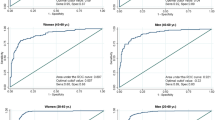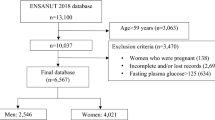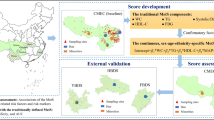Abstract
Aims/hypothesis
We validated the metabolic syndrome (MetS) score by confirmatory factor analysis (CFA) in children, middle-aged men, and older women and men and by investigating the relationships of the MetS score to incident type 2 diabetes, myocardial infarction, and cardiovascular and overall death in middle-aged men.
Methods
We assessed the core features of MetS, calculated the MetS score using z scores for waist circumference, insulin, glucose, triacylglycerols, HDL-cholesterol and blood pressure, and carried out CFA to investigate whether MetS represents a single entity in population samples of 491 children, 1,900 middle-aged men, 614 older women and 555 older men from Finland. We also followed-up incident type 2 diabetes for 11 years and other outcomes for 17–18 years in middle-aged men.
Results
We carried out second-order CFAs in which the MetS was represented by a second-order latent variable underlying four latent variables characterised by abdominal obesity, insulin resistance, dyslipidaemia and raised blood pressure in different age groups. These second-order factors and factors derived from first-order CFA using previously proposed models were strongly associated with a composite MetS score in all age groups (r = 0.84–0.94) and similarly predicted type 2 diabetes, cardiovascular outcomes and mortality in middle-aged men. The risk of type 2 diabetes, myocardial infarction, cardiovascular death and overall death increased 3.67-, 1.38-, 1.56- and 1.44-fold, respectively, for a 1 SD increase in the MetS score.
Conclusions
The MetS can be described as a single entity in all age groups. The MetS score is a valid tool for research evaluating cardiometabolic risk in different age groups. Further research is needed to define cut-off points for risk estimation in clinical practice.

Similar content being viewed by others
Abbreviations
- CFA:
-
Confirmatory factor analysis
- CFI:
-
Comparative fit index
- CVD:
-
Cardiovascular disease
- MAP:
-
Mean arterial pressure
- MetS:
-
Metabolic syndrome
- RMSEA:
-
Root mean square of approximation
References
Alberti KG, Eckel RH, Grundy SM et al (2009) Harmonizing the metabolic syndrome: a joint interim statement of the International Diabetes Federation Task Force on Epidemiology and Prevention; National Heart, Lung, and Blood Institute; American Heart Association; World Heart Federation; International Atherosclerosis Society; and International Association for the Study of Obesity. Circulation 120:1640–1645
Kassi E, Pervanidou P, Kaltsas G, Chrousos G (2011) Metabolic syndrome: definitions and controversies. BMC Med 9:48
Grundy SM (2008) Metabolic syndrome pandemic. Arterioscler Thromb Vasc Biol 28:629–636
Flegal KM, Carroll MD, Kit BK, Ogden CL (2012) Prevalence of obesity and trends in the distribution of body mass index among US adults, 1999–2010. JAMA 307:491–497
Morrison JA, Friedman LA, Gray-McGuire C (2007) Metabolic syndrome in childhood predicts adult cardiovascular disease 25 years later: the Princeton Lipid Research Clinics Follow-up Study. Pediatrics 120:340–345
Morrison JA, Friedman LA, Wang P, Glueck CJ (2008) Metabolic syndrome in childhood predicts adult metabolic syndrome and type 2 diabetes mellitus 25 to 30 years later. J Pediatr 152:201–206
Laaksonen DE, Lakka HM, Niskanen LK, Kaplan GA, Salonen JT, Lakka TA (2002) Metabolic syndrome and development of diabetes mellitus: application and validation of recently suggested definitions of the metabolic syndrome in a prospective cohort study. Am J Epidemiol 156:1070–1077
McNeill AM, Rosamond WD, Girman CJ et al (2005) The metabolic syndrome and 11-year risk of incident cardiovascular disease in the atherosclerosis risk in communities study. Diabetes Care 28:385–390
Lakka HM, Laaksonen DE, Lakka TA et al (2002) The metabolic syndrome and total and cardiovascular disease mortality in middle-aged men. JAMA 288:2709–2716
Brambilla P, Lissau I, Flodmark CE et al (2007) Metabolic risk-factor clustering estimation in children: to draw a line across pediatric metabolic syndrome. Int J Obes (Lond) 31:591–600
Steinberger J, Daniels SR, Eckel RH et al (2009) Progress and challenges in metabolic syndrome in children and adolescents: a scientific statement from the American Heart Association Atherosclerosis, Hypertension, and Obesity in the Young Committee of the Council on Cardiovascular Disease in the Young; Council on Cardiovascular Nursing; and Council on Nutrition, Physical Activity, and Metabolism. Circulation 119:628–647
Andersen LB, Harro M, Sardinha LB et al (2006) Physical activity and clustered cardiovascular risk in children: a cross-sectional study (The European Youth Heart Study). Lancet 368:299–304
Eisenmann JC, Laurson KR, DuBose KD, Smith BK, Donnelly JE (2010) Construct validity of a continuous metabolic syndrome score in children. Diabetol Metab Syndr 2:8
Pandit D, Chiplonkar S, Khadilkar A, Kinare A, Khadilkar V (2011) Efficacy of a continuous metabolic syndrome score in Indian children for detecting subclinical atherosclerotic risk. Int J Obes (Lond) 35:1318–1324
Hanley AJ, Karter AJ, Festa A et al (2002) Factor analysis of metabolic syndrome using directly measured insulin sensitivity: The Insulin Resistance Atherosclerosis Study. Diabetes 51:2642–2647
Martinez-Vizcaino V, Martinez MS, Aguilar FS et al (2010) Validity of a single-factor model underlying the metabolic syndrome in children: a confirmatory factor analysis. Diabetes Care 33:1370–1372
Child D (1990) The essentials of factor analysis. Cassell, London
Li C, Ford ES (2007) Is there a single underlying factor for the metabolic syndrome in adolescents? A confirmatory factor analysis. Diabetes Care 30:1556–1561
Shen BJ, Todaro JF, Niaura R et al (2003) Are metabolic risk factors one unified syndrome? Modeling the structure of the metabolic syndrome X. Am J Epidemiol 157:701–711
Pladevall M, Singal B, Williams LK et al (2006) A single factor underlies the metabolic syndrome: a confirmatory factor analysis. Diabetes Care 29:113–122
Hillier TA, Rousseau A, Lange C et al (2006) Practical way to assess metabolic syndrome using a continuous score obtained from principal components analysis. Diabetologia 49:1528–1535
Viitasalo A, Laaksonen DE, Lindi V et al (2012) Clustering of metabolic risk factors is associated with high-normal levels of liver enzymes among 6- to 8-year-old children: the PANIC Study. Metab Syndr Relat Disord 10:337–343
Hassinen M, Lakka TA, Savonen K et al (2008) Cardiorespiratory fitness as a feature of metabolic syndrome in older men and women: the Dose-Responses to Exercise Training Study (DR's EXTRA). Diabetes Care 31:1242–1247
Ekelund U, Anderssen SA, Froberg K et al (2007) Independent associations of physical activity and cardiorespiratory fitness with metabolic risk factors in children: the European Youth Heart Study. Diabetologia 50:1832–1840
Kahn R, Buse J, Ferrannini E, Stern M (2005) The metabolic syndrome: time for a critical appraisal. Joint statement from the American Diabetes Association and the European Association for the Study of Diabetes. Diabetologia 48:1684–1699
Wijndaele K, Beunen G, Duvigneaud N et al (2006) A continuous metabolic syndrome risk score: utility for epidemiological analyses. Diabetes Care 29:2329
Eisenmann JC (2008) On the use of a continuous metabolic syndrome score in pediatric research. Cardiovasc Diabetol 7:17
Meigs JB (2000) Invited commentary: insulin resistance syndrome? Syndrome X? Multiple metabolic syndrome? A syndrome at all? Factor analysis reveals patterns in the fabric of correlated metabolic risk factors. Am J Epidemiol 152:908–911, discussion 912
Laaksonen DE, Niskanen L, Lakka HM, Lakka TA, Uusitupa M (2004) Epidemiology and treatment of the metabolic syndrome. Ann Med 36:332–346
Martinez-Vizcaino V, Ortega FB, Solera-Martinez M et al (2011) Stability of the factorial structure of metabolic syndrome from childhood to adolescence: a 6-year follow-up study. Cardiovasc Diabetol 10:81
Povel C, Beulens J, van der Schouw Y et al (2012) Metabolic syndrome model definitions predicting type 2 diabetes and cardiovascular disease. Diabetes Care 36:362–368
Siegel MJ, Hildebolt CF, Bae KT, Hong C, White NH (2007) Total and intraabdominal fat distribution in preadolescents and adolescents: measurement with MR imaging. Radiology 242:846–856
Benfield LL, Fox KR, Peters DM et al (2008) Magnetic resonance imaging of abdominal adiposity in a large cohort of British children. Int J Obes (Lond) 32:91–99
Cole TJ, Bellizzi MC, Flegal KM, Dietz WH (2000) Establishing a standard definition for child overweight and obesity worldwide: international survey. BMJ 320:1240–1243
Cornier MA, Dabelea D, Hernandez TL et al (2008) The metabolic syndrome. Endocr Rev 29:777–822
Widhalm K, Ghods E (2010) Nonalcoholic fatty liver disease: a challenge for pediatricians. Int J Obes (Lond) 34:1451–1467
Bennett B, Larson-Meyer DE, Ravussin E et al (2011) Impaired insulin sensitivity and elevated ectopic fat in healthy obese vs. nonobese prepubertal children. Obesity (Silver Spring) 20:371–375
Acknowledgements
We thank the personnel of the PANIC Study, The KIHD Study and the DR’s EXTRA Study for performing these population-based studies.
Funding
The PANIC Study was financially supported by the Ministry of Social Affairs and Health of Finland 1491/9.02.00/2009, the Ministry of Education and Culture of Finland 121/627/2009, the Finnish Innovation Fund Sitra, the Social Insurance Institution of Finland 22/26/2008, the Finnish Cultural Foundation, the Juho Vainio Foundation, the Foundation for Pediatric Research, and the Kuopio University Hospital EVO 5031343. The KIHD Study was supported by grants 41471, 1041086 and 2041022 from the Academy of Finland, 167/722/96, 157/722/97 and 156/722/98 from the Ministry of Education of Finland, HL44199 from the National Heart, Lung, and Blood Institute of the USA, and the City of Kuopio. The DR’s EXTRA Study was supported by grants from the Ministry of Education and Culture of Finland (722 and 627), 2004–2010, the Academy of Finland (102318, 104943, 123885 and 211119), the Social Insurance Institution of Finland (4/26/2010), the European Commission FP6 Integrated Project LSHM-CT-2004-005272, the Päivikki and Sakari Sohlberg Foundation, the Finnish Diabetes Association, the Finnish Foundation for Cardiovascular Research, the City of Kuopio, and the Kuopio University Hospital.
Duality of interest
The authors declare that there is no duality of interest associated with this manuscript.
Contribution statement
AV and DEL analysed the data. AV, DEL and TAL wrote the manuscript. All authors contributed to data collection, reviewed the manuscript and approved the final version. TAL is the guarantor of the work and takes responsibility for the contents of this article.
Author information
Authors and Affiliations
Corresponding author
Electronic supplementary material
Below is the link to the electronic supplementary material.
ESM Methods
(PDF 185 kb)
ESM Table 1
(PDF 98 kb)
ESM Table 2
(PDF 99 kb)
ESM Table 3
(PDF 98 kb)
ESM Table 4
(PDF 98 kb)
ESM Fig 1
(PDF 144 kb)
Rights and permissions
About this article
Cite this article
Viitasalo, A., Lakka, T.A., Laaksonen, D.E. et al. Validation of metabolic syndrome score by confirmatory factor analysis in children and adults and prediction of cardiometabolic outcomes in adults. Diabetologia 57, 940–949 (2014). https://doi.org/10.1007/s00125-014-3172-5
Received:
Accepted:
Published:
Issue Date:
DOI: https://doi.org/10.1007/s00125-014-3172-5




